Related Research Articles

Lumberjacks are mostly North American workers in the logging industry who perform the initial harvesting and transport of trees for ultimate processing into forest products. The term usually refers to a bygone era when hand tools were used in harvesting trees. Because of its historical ties, the term lumberjack has become ingrained in popular culture through folklore, mass media and spectator sports. The actual work was difficult, dangerous, intermittent, low-paying, and primitive in living conditions. However, the men built a traditional culture that celebrated strength, masculinity, confrontation with danger, and resistance to modernization.

Millinocket is a town in Penobscot County, Maine, United States.

The St. Croix River is a river in northeastern North America, 71 miles (114 km) in length, that forms part of the Canada–United States border between Maine (U.S.) and New Brunswick (Canada). The river rises in the Chiputneticook Lakes and flows south and southeast, between Calais and St. Stephen. It discharges into Passamaquoddy Bay, in the Bay of Fundy.

The Penobscot River is a 109-mile-long (175 km) river in the U.S. state of Maine. Including the river's West Branch and South Branch increases the Penobscot's length to 264 miles (425 km), making it the second-longest river system in Maine and the longest entirely in the state. Its drainage basin contains 8,610 square miles (22,300 km2).

The Sandy River & Rangeley Lakes Railroad (SR&RL) was a 2 ft narrow gauge common carrier railroad that operated approximately 112 miles (180 km) of track in Franklin County, Maine. Former equipment from the SR&RL continues to operate in the present day on a revived, short segment of the railway in Phillips, Maine.

The North Carolina Transportation Museum is a museum in Spencer, North Carolina. It is a collection of automobiles, aircraft, and railway vehicles. The museum is located at the former Southern Railway's 1896-era Spencer Shops and devotes much of its space to the state's railroad history. The museum has the largest collection of rail relics in the Carolinas. Its Back Shop building of nearly three stories high is most notable for its size of two football fields long.
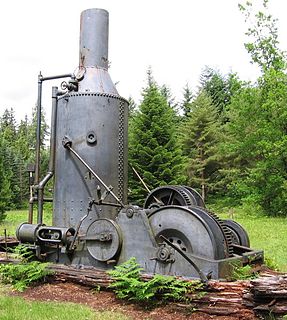
Steam donkey, or donkey engine, is the common nickname for a steam-powered winch, or logging engine, widely used in past logging operations, though not limited to logging. They were also found in the mining, maritime, and nearly any other industry that needed a powered winch. Donkeys were often attached to a yarder.
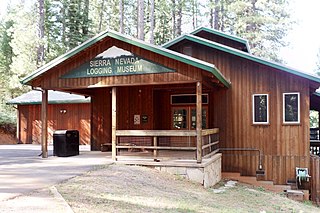
The Sierra Nevada Logging Museum is a museum dedicated to preserving the history of logging in the Sierra Nevada region. The museum is located on California State Route 4 in the Stanislaus National Forest, near Arnold, in Calaveras County, California, United States.

The BC Forest Discovery Centre, located in Duncan, chronicles the history of logging in British Columbia, Canada. It is a 100-acre (40 ha) site with 2.5 km of operational 3 ft narrow gauge railway.
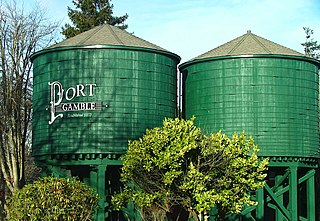
Port Gamble is an unincorporated community on the northwestern shore of the Kitsap Peninsula in Kitsap County, Washington, United States. It is also a small, eponymous bay, along which the community lies, near the entrance to Hood Canal. The unincorporated communities of Port Gamble and Little Boston, part of Kitsap County, lie on the west and the east side, respectively, of the mouth of this bay. The Port Gamble Historic District, a U.S. National Historic Landmark, covers one of the nation's best-preserved western lumber towns.

The Backus Heritage Conservation Area is located in Norfolk County, Ontario, Canada.

The Pennsylvania Lumber Museum is near Galeton, Potter County, Pennsylvania in the United States. It documents the history and technology of the lumber industry that was a vital part of the economic development and ecological destruction of Pennsylvania.

Collier Memorial State Park is a state park in southern Oregon. The park is operated and maintained by the Oregon Parks and Recreation Department. It is located on U.S. Highway 97, approximately 30 miles (48 km) north of Klamath Falls and 105 miles (169 km) south of Bend. The park covers 146 acres (59 ha) along the Williamson River.

The Museum L-A, with the full name of Museum L-A: The Story of Work and Community in Lewiston-Auburn, is located in the Bates Mill Historic District, in Lewiston, Androscoggin County, Maine.

Established in 1967 by the County of Peterborough, Lang Pioneer Village Museum is an award-winning living history museum located in the hamlet of Lang in Peterborough County, Ontario. Lang Pioneer Village is situated on the shores of the historic Indian River. Lang Pioneer Village is an "outdoor museum" featuring more than 30 restored and furnished buildings, many of which were donated from the surrounding townships. The buildings, constructed between 1820 and 1899, are interpreted by costumed villagers portraying authentic 19th-century pioneer life. Since 2014 the Museum has been the site of the Aabnaabin Encampment, a pre-colonization representation of a Michi Saagiig camp where the story of the First Nations history and culture of the region is told by indigenous interpreters. In October 2017, Lang Pioneer Village Museum was designated Ontario's Choice Top Small Museum / Art Gallery / Historic Site by popular vote in an online contest sponsored by Attractions Ontario. Lang Pioneer Village Museum is owned and operated by the County of Peterborough.
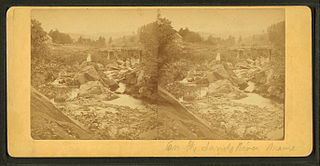
The Sandy River is a 73.3-mile-long (118.0 km) tributary of the Kennebec River in the U.S. state of Maine.

The West Branch Penobscot River is a 117-mile-long (188 km) tributary of the Penobscot River through the North Maine Woods in Maine. The river is also known as Abocadneticook, Kahgognamock, and Kettegwewick.

Rangeley is a town in Franklin County, Maine, United States. The population was 1,168 at the 2010 census. Rangeley is the center of the Rangeley Lakes Region, a resort area. The town includes the villages of Oquossoc, Haines Landing and South Rangeley.
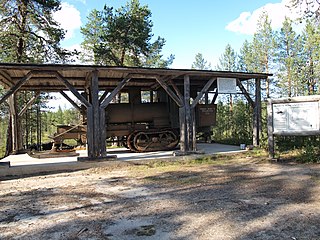
The Phoenix Manufacturing Company, later the Phoenix Steel Company, was one of Eau Claire, Wisconsin's oldest manufacturing firms. It manufactured equipment predominantly for the sawmill and logging equipment industries, which were vital to the establishment and growth of Eau Claire.

Elgin Vale Sawmill is a heritage-listed sawmill at Manumbar Road, Elgin Vale, Gympie Region, Queensland, Australia. It was built in 1944 for T H Spencer by Wilson Hart Limited. It was added to the Queensland Heritage Register on 17 September 2010.
References
- ↑ Shavings, Early American Industries Association, 1999, 88.
- ↑ "Mission and History" . Retrieved 6 April 2020.